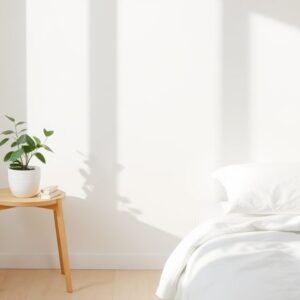Have you ever thought about why minimalist home organization might be a good fit for you, especially in our busy lives? Embracing minimalism can really change how your home feels. Imagine walking into a space that not only looks clean but also represents what you value.
This approach helps cut down on distractions that can clutter your mind, making it easier to focus on what truly matters. It's not just about keeping things neat; it's about creating an environment that supports your goals and routines. When you start to see the advantages of minimalism, you may discover it leads to a more intentional way of living.
So, what does it take to make this shift in how you think and live? To get started, consider decluttering your space. Begin with one room or even just one drawer. Take everything out, and only put back what you love or use regularly.
For example, if you have a kitchen drawer overflowing with utensils, ask yourself which ones you actually use. Maybe you only need one good chef's knife and a couple of spoons. You can donate or recycle the extras. This not only frees up space but also makes it easier to find what you need when you need it.
Investing in storage solutions, like clear bins or stylish baskets, can also help keep your items organized and visible, reducing the temptation to accumulate more. Remember, minimalism is about quality over quantity.
By focusing on keeping just what serves you well or brings you joy, you create a home that truly feels like yours. So, are you ready to embrace a more organized and meaningful way of living?
Key Takeaways
Why Embrace Minimalist Home Organization?
Adopting minimalist home organization can truly transform your living space and mindset. When you reduce clutter, you not only create a cleaner environment but also enhance your mental clarity. Imagine walking into a room that feels open and organized; this can help you focus better and spark your creativity in everyday tasks.
Furthermore, embracing a minimalist approach allows you to maximize your functional space. For instance, consider a small apartment where every square foot counts. By using multi-purpose furniture, like a coffee table that doubles as storage or a sofa bed for guests, you can optimize your living area, making it more usable and enjoyable.
Another benefit of minimalism is how it simplifies your daily routines. When you streamline your tasks, like having a designated spot for keys and bags, you establish clear boundaries in your life. This can lead to increased productivity and a greater sense of well-being. For example, a simple morning routine that involves a quick tidy-up can set a positive tone for the day ahead.
Regularly assessing your belongings is also key to emotional well-being. By taking the time to evaluate what you truly need and what aligns with your values, you can make thoughtful decisions about what to keep and what to let go of. This not only lightens your physical load but also offers a sense of relief and clarity.
Finally, incorporating sustainable organization practices into your home can minimize waste. This means finding ways to declutter that are not just about tossing items but rather recycling, donating, or repurposing them. By doing so, you create a peaceful and inviting atmosphere in your home that reflects a more intentional way of living. Imagine how calming it feels to come home to a space that resonates with your values and aspirations—this is the essence of minimalist home organization.
Understanding Minimalism
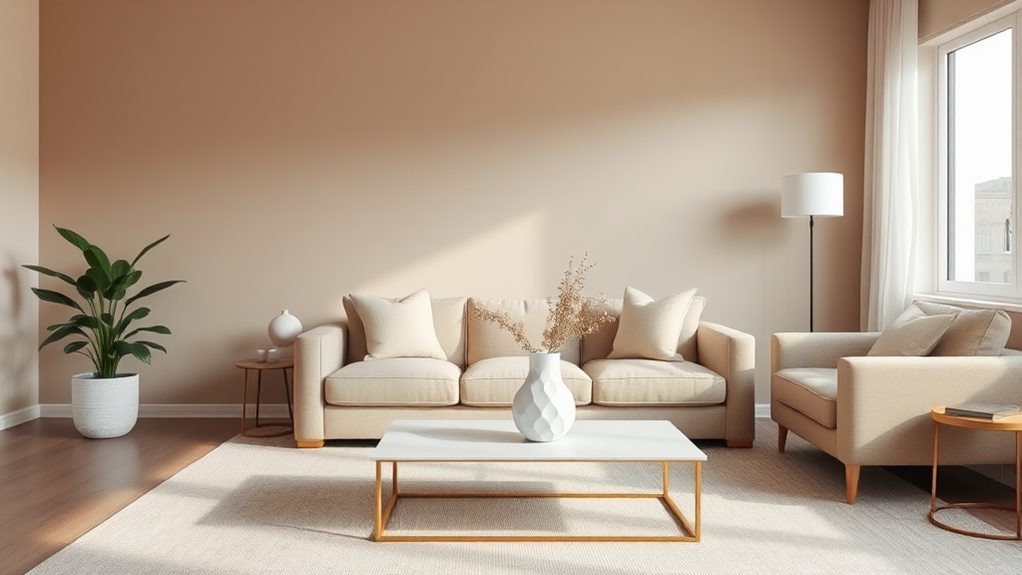
Minimalism isn't just a trendy aesthetic; it's a way of living that encourages you to prioritize what truly matters in your life. When you embrace minimalism, you're not just clearing out your closet; you're also making space in your mind and your daily routines. It's about simplifying everything around you so you can focus on what brings you joy and fulfillment.
Think about it: in a world filled with distractions, choosing quality over quantity can transform your life. Take a moment to evaluate your belongings and commitments. Keep only the items and activities that genuinely enhance your life. This mindful approach helps you make smarter choices about what you allow into your home and your life, leading to a more peaceful existence.
To begin your minimalist journey, start with a simple exercise: go through your things and ask yourself whether each item serves a purpose or brings you happiness. If it doesn't, it might be time to let it go. This not only declutters your physical space but also clears your mind, fostering a sense of calm.
Incorporate minimalism into your everyday habits by setting focused goals. Limit distractions—like putting your phone away during work or designating quiet time for yourself.
Create a space at home that reflects your values, perhaps by using simple furniture and decor that resonates with you. By understanding and embracing minimalism, you can pave the way to a more intentional and rewarding life.
Benefits of Minimalist Organization
Adopting a minimalist approach to organization can significantly boost your mental clarity. When you reduce the number of items in your environment, you minimize distractions, which can help you concentrate better and make decisions more easily.
Imagine entering a room that feels open and inviting because there's less clutter. This not only creates a more pleasant atmosphere but also gives you more functional space to move around.
For example, consider using stylish storage solutions, like decorative baskets or sleek shelving units, to keep your essentials organized without overwhelming your space.
Enhanced Mental Clarity
When your environment is clutter-free, it becomes easier for your mind to relax and focus. Embracing a minimalist approach to organization not only clears your physical space but also opens up mental space. A tidy area helps reduce distractions, allowing you to concentrate on the things that truly matter to you. With fewer items competing for your attention, you'll notice a significant boost in your mental clarity.
Think about the last time you felt overwhelmed by the mess around you. Each item in your home demands some level of mental energy, whether it's consciously or subconsciously. By simplifying what you own, you lighten your mental load. This change can enhance both your decision-making abilities and your creativity, making it easier to come up with new ideas.
To get started, take a good look at your belongings. Identify things that no longer serve a purpose or bring you happiness. Letting go of these extra items can create space for clarity and intentionality in your life.
A minimalist organization strategy means you'll spend less time hunting for items and more time pursuing activities that inspire you, like painting, cooking, or reading.
Ultimately, adopting a minimalist organization style not only brings peace to your living space but also nurtures your mental clarity. So why not take that first step today? Start decluttering your space and see how it can transform your focus and calm your mind.
For a more organized approach, consider using simple storage solutions like clear bins or label makers. These tools can help you maintain the clarity you've worked hard to achieve.
Increased Functional Space
A clutter-free environment can really open up your living space, making each area of your home feel more functional and inviting. When you adopt a minimalist approach to organization, you can create layouts that truly fit your lifestyle.
You might be surprised at how spaces that were once overwhelmed with unnecessary items can now be transformed into areas that serve multiple purposes, improving the overall flow of your home.
Let's explore some practical ways to maximize your space with versatile furnishings:
- Imagine turning a small nook into a cozy reading corner. A compact chair paired with a small bookshelf can create an inviting spot for relaxation without taking up much room.
- Under-bed storage is a game changer for keeping your bedroom tidy. Consider using clear bins or vacuum-sealed bags to store seasonal clothing and linens, helping to maintain a calm, spacious atmosphere.
- Opting for multifunctional tables can really enhance your space. Look for a table that can function as a workspace during the day, a dining area for meals, and even a game table for family game nights.
- Wall-mounted shelves are also a smart choice. They allow you to showcase your favorite decor pieces without sacrificing valuable floor space, giving your home a more open feel.
By simplifying your environment, you'll uncover new chances for creativity and relaxation. Each item you choose to keep can serve a purpose, contributing to a more organized and efficient lifestyle.
When clutter is out of the picture, you'll find that your home feels more spacious and welcoming. So why not give minimalist organization a try? You might just find that your functional space flourishes in ways you never expected!
The Decluttering Mindset
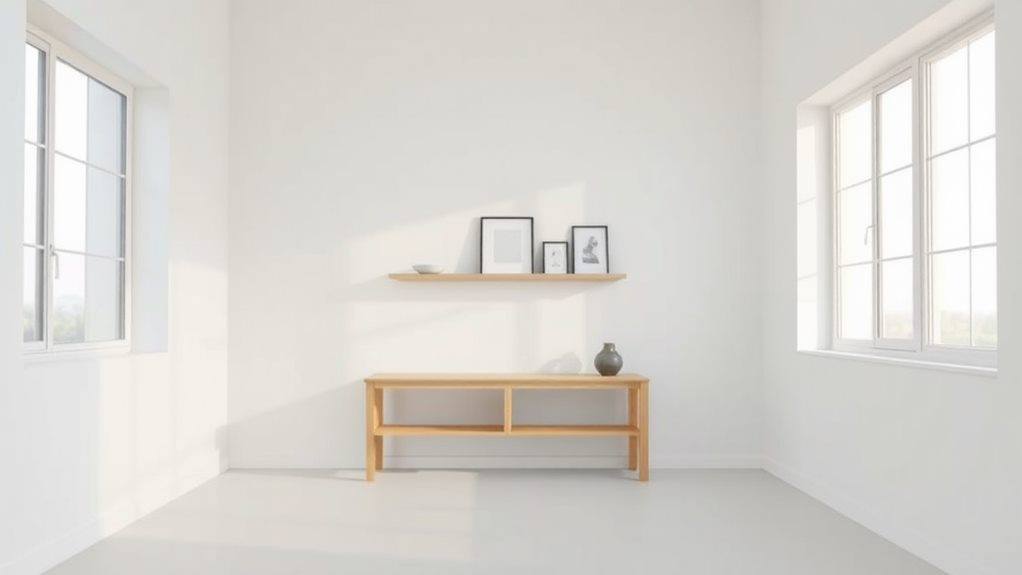
To shift to a decluttering mindset, it's important to release the emotional ties we often form with our belongings.
Begin by assessing what genuinely enhances your life. Ask yourself, "Does this item serve a purpose or bring me joy?" This evaluation helps you identify the essentials that matter most to you.
For instance, if you have a collection of mugs but only drink coffee from one favorite, consider donating the rest.
Streamlining your possessions not only frees up physical space but also clears your mind, allowing you to concentrate on what truly counts—like spending more time with family or pursuing hobbies you love.
Letting Go Emotionally
Letting go emotionally is a crucial part of decluttering your life. It can be tough to part with items that hold sentimental value, and this emotional attachment can really slow down your personal growth. When you find yourself clinging to nostalgic items, it can lead to what's known as decision fatigue, making it hard to see their true value in your life. Instead of seeing this as a burden, try to view it as a chance for self-discovery and emotional freedom.
Here are a few things to keep in mind that might help you on this journey:
- Think about the excitement of creating space for new experiences. When you let go of the old, you open up room for the new.
- Recognize that holding onto unused items often keeps you tethered to past memories that may not serve you anymore.
- Consider the liberation that comes with releasing attachment styles that no longer benefit you.
- Understand that decluttering your space can lead to increased clarity in your life.
It's important to realize that not everything you own needs to stay with you. By tuning into the emotions tied to your belongings, you can make thoughtful decisions that lead to a lighter, more satisfying existence.
Give yourself the green light to let go of what no longer serves your journey. Each item you release is a step toward a clearer mindset, and it opens the door for personal growth and new opportunities.
Embrace this process; letting go isn't just about clearing physical space—it's about making room for new memories and experiences that truly matter.
Simplifying Daily Routines
Making your daily routines simpler can really boost your productivity and improve how you feel overall.
Let's start with your mornings. One effective way to do this is by planning your outfit the night before and prepping an easy breakfast. By deciding these things ahead of time, you'll avoid the stress of making choices when you first wake up, which can help set a positive mood for the day.
Also, try putting your phone on silent and picking a specific time to check emails. This way, you can focus better on your tasks without interruptions.
In the evenings, it's helpful to create some good habits too. Set aside a time to tidy up your space, putting away things that don't belong. This not only makes your environment more pleasant but gives you a moment to think about your day and get ready for tomorrow.
Consider jotting down a to-do list for the next day to clear your mind before you sleep.
Keeping a consistent routine in the morning and evening can help you stay focused and lower your stress levels. Make it a point to keep your space organized so you can find things easily.
The less physical and mental clutter you have, the more energy you'll have for the important stuff in your life. By adopting these simple changes, you're likely to notice a significant improvement in both your efficiency and your overall peace of mind.
Assessing Your Space
Before you jump into organizing your home with a minimalist approach, it's crucial to take a good look at your space. Evaluating your environment is a vital first step because it helps you figure out what you really need and what you can let go of. This assessment lays the groundwork for a peaceful and organized home.
Begin by strolling through each room and paying attention to a few key areas:
- Identify the clutter that seems to pile up and stress you out on a daily basis.
- Notice any items that bring back unpleasant memories or feelings.
- Look for spaces that feel chaotic or unwelcoming, perhaps a crowded kitchen counter or a cluttered living room.
- Spot areas where things become too overwhelming, making it hard to use the space effectively.
As you assess each room, think about its intended purpose and whether it's fulfilling that role. Ask yourself questions like, "Do I really use this item?" or "Does this piece bring happiness into my life?"
This reflective mindset will help you make thoughtful choices as you declutter. For instance, if you find a stack of magazines that you haven't touched in months, consider whether they serve any purpose in your life.
Maybe it's time to recycle them and make room for items that truly matter. This kind of intentional evaluation is key to creating a home that feels inviting and functional.
Step-by-Step Decluttering
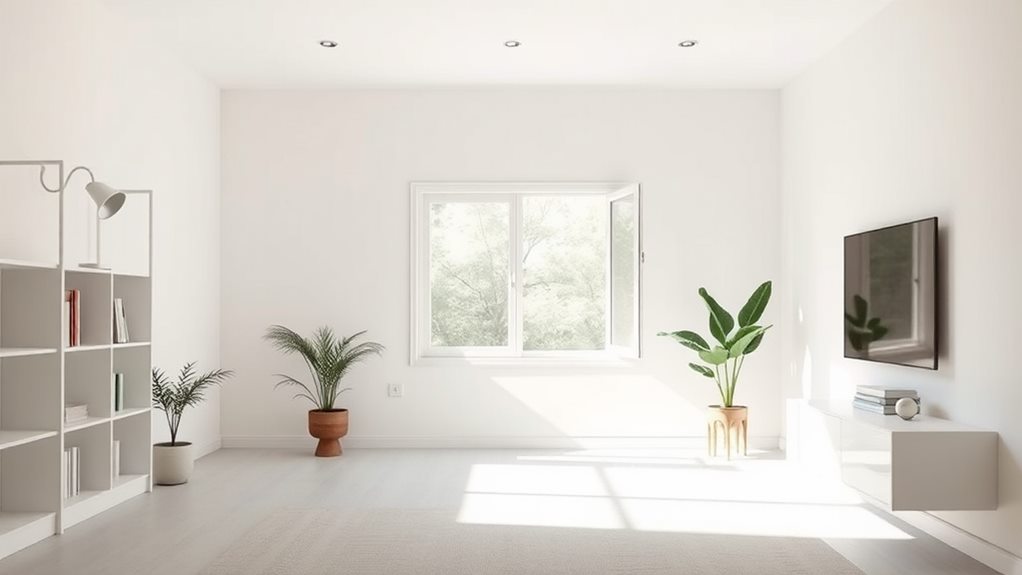
Decluttering your home doesn't have to be overwhelming. By breaking it down into small, manageable steps, you can make the process feel much more achievable. The first step is to adopt a minimalist mindset. This means focusing on the items that truly matter to you and letting go of the rest. A declutter checklist can be a helpful tool to keep you on track as you work through each area of your home.
Let's walk through a simple step-by-step approach that you can follow:
- Choose a Room: Start with just one room. This helps you maintain focus and not get distracted by the bigger picture. For example, if you start with your bedroom, you'll be able to create a calming space for rest.
- Set a Timer for 30 Minutes: Having a time limit can create a sense of urgency and help you stay motivated. It's a short enough time that you won't feel overwhelmed, but long enough to make progress.
- Sort Items into Categories: As you go through your things, create three piles: Keep, Donate, and Discard. This makes it easier to visualize what you have and what you no longer need. For instance, if you come across a pair of shoes you haven't worn in a year, consider donating them instead of letting them take up valuable space.
- Evaluate Each Item: Take a moment to think about the value of each item. Ask yourself if it brings you joy or serves a purpose. This reflection can help you make more intentional decisions about what to keep.
- Act on Your Decisions: Once you've made your choices, take immediate action. Put the items in the donation pile in your car, or find a local charity that can use them. This step is crucial because it prevents second-guessing your decisions later.
By following these steps, you can transform your space into one that feels more organized and reflects what you truly value.
Effective Sorting Techniques
To sort your items effectively, begin with a decluttering strategy that resonates with you. It's important to create a system that feels manageable, as this will make the process less overwhelming.
Next, sort your belongings into distinct categories: items you want to keep, those you can donate, and things that should be discarded. For example, you might find that clothes you haven't worn in over a year can be donated to a local charity, and broken items should go straight into the trash.
Decluttering Strategies
When you decide to tackle the clutter in your home, using effective sorting methods can truly make a difference.
Begin by focusing on practical decluttering techniques that emphasize evaluating each item you own. As you go through your belongings, consider whether each item genuinely enhances your life. This approach helps you move past emotional attachments and promotes thoughtful purchasing habits.
Here are some impactful strategies to consider:
- Picture your dream space and the vibe you want it to convey. For instance, if you envision a calm and serene environment, think about how you can reduce visual noise by minimizing decorations or keeping surfaces clear.
- Establish a specific time frame for each decluttering session. This helps maintain your motivation. For example, you might set a timer for 30 minutes and challenge yourself to sort through a particular area within that time.
- Plan how you'll donate items you no longer need. Imagine the happiness your unused clothes could bring to someone in need. Look for local charities or organizations that align with your values.
- Explore storage solutions that optimize your space. Consider using clear bins or drawer dividers to keep things organized, ensuring every item has a designated spot.
Categorization Methods
Sorting through your belongings can be a daunting task, but using smart categorization methods can make it much more manageable. One effective approach is room zoning—this means designating specific areas in your home for different categories of items. For example, you could set up a cozy reading nook in a corner of your living room, filled with books and comfy seating. This way, similar items are kept together, making it much easier to find what you need when you need it.
To enhance this organization, consider using category labels. Labeling drawers and bins helps clarify what belongs where. For instance, if you have a bin for craft supplies, a simple label can save you time looking for that elusive pair of scissors.
You can also use drawer dividers to separate different items within your drawers, ensuring everything stays in its designated spot and doesn't turn into a chaotic jumble.
Another fun and effective method is color coding your items. This not only makes it easier to find what you're looking for, but it also adds a visually pleasing element to your space. For example, arrange your craft supplies or books by color to create an eye-catching display that's both functional and beautiful.
When it comes to digital organization, don't forget to apply a systematic approach to your electronic files. Organizing your files into folders and subfolders can help keep your digital space just as tidy as your physical one. For instance, you could create a main folder for work documents and then subfolders for different projects or clients.
Additionally, consider implementing seasonal sorting for your clothes and decorations. This means rotating items based on the time of year—like storing away summer clothes in the fall and bringing out cozy winter sweaters. It not only saves space but also ensures you're only surrounded by things that are relevant to the current season.
Lastly, practice priority sorting by identifying which items are essential and should be easily accessible. This means keeping everyday essentials like your keys or wallet in a designated spot, so they're easy to grab when you're heading out the door.
These methods encourage minimalist storage and help you maintain a clutter-free environment, making your home feel more inviting and organized.
Maintaining a Minimalist Home
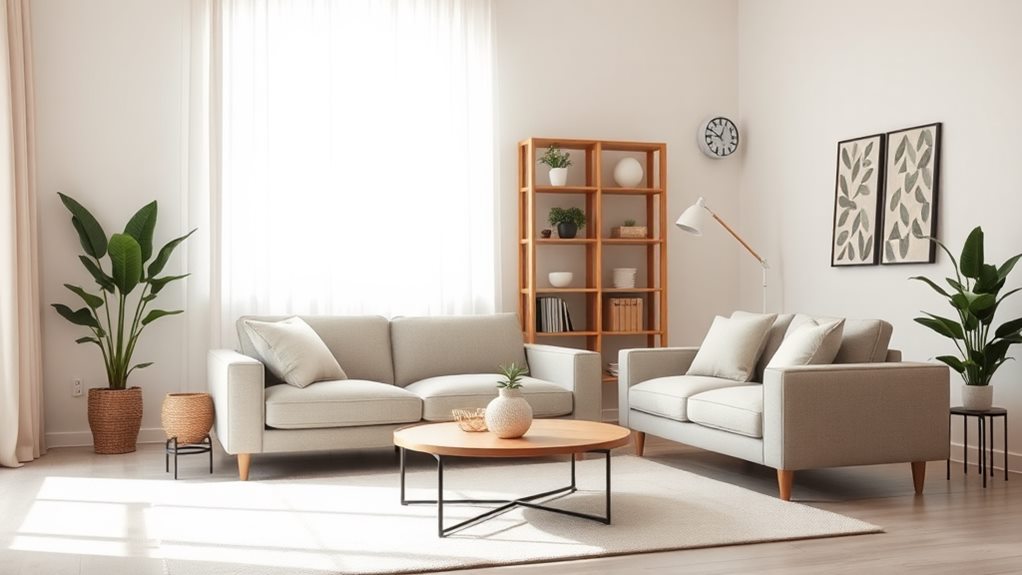
Keeping a minimalist home is an ongoing journey that requires your attention and effort. It's not just a one-time decluttering event; it's a way of life that shows how much you value simplicity and thoughtful living. To maintain a calm and functional space, it's essential to regularly check in on your belongings and be mindful of what you allow into your home.
Here are some emotional drivers to help you stay inspired:
- Clarity: When your space is tidy, it can help clear your mind, making it easier to focus on what really matters.
- Freedom: Having less stuff means you can move with ease and enjoy a more open environment.
- Joy: Fill your home only with items that bring you happiness or serve a purpose in your life.
- Focus: A minimalist setting can significantly enhance your productivity by reducing distractions.
Make it a regular practice to look through your belongings and let go of items that no longer benefit you. Consider setting aside some time each month to reflect on what you own and ensure everything aligns with your personal values and goals.
When you're out shopping, think carefully about whether a new item will genuinely add value to your life before you buy it. This habit of continual assessment not only keeps your home organized but also strengthens your commitment to a minimalist lifestyle.
Ultimately, your home should be a sanctuary of peace and simplicity. By sticking to these principles, you can enjoy the many advantages that come with living minimally—like reduced stress and greater clarity in your daily life.
Sustainable Organization Practices
Sustainable organization practices can enhance your home while also benefiting the environment. By opting for eco-friendly storage solutions, you create a space that reflects your commitment to sustainability.
Begin by assessing what you already own. Instead of purchasing new items, think about how you can repurpose containers and furniture. For instance, glass jars can be great for storing small items like buttons or craft supplies, and old boxes can effectively organize documents or books.
When it's time to buy new storage options, choose materials that are good for the planet. Look for shelves and bins made from bamboo, recycled plastic, or reclaimed wood. These materials not only reduce your environmental footprint but can also introduce a charming, unique touch to your decor.
Another useful approach is the "one in, one out" rule. For every new item you bring into your home, consider letting go of something else. This strategy not only keeps clutter at bay but also promotes more thoughtful purchasing habits.
Additionally, think about investing in multi-functional furniture. Pieces that serve various purposes can help save space and lessen the need for extra items. For example, a coffee table with storage or a bed with drawers underneath can be incredibly useful.
Tools for Minimalist Living
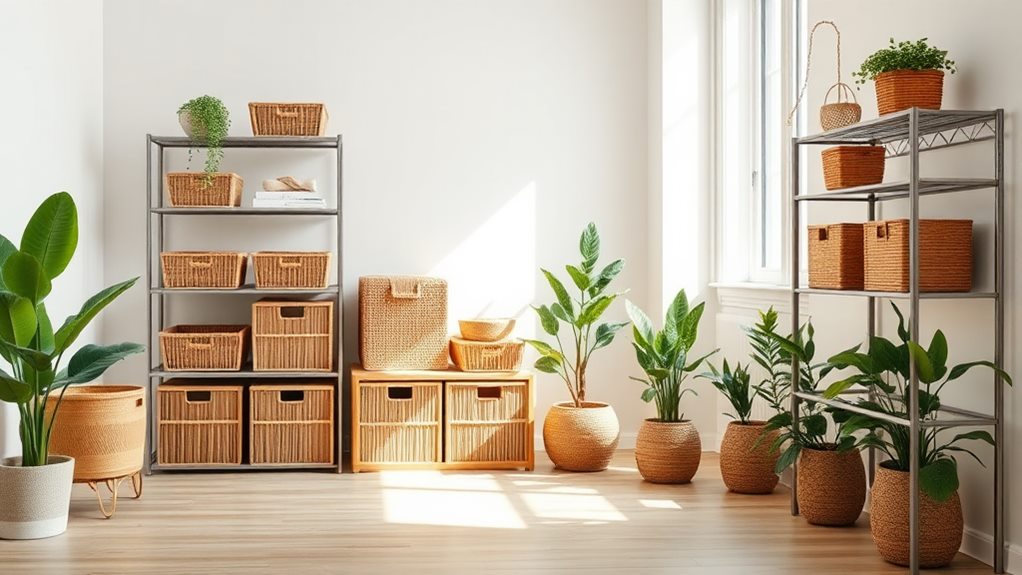
To embrace minimalist living, having the right tools can make a significant difference in simplifying your space and enhancing how it functions.
These tools not only help you embrace the principles of simplicity but also facilitate the creation of a peaceful environment. By integrating effective storage solutions and organization methods, you can declutter your home and cultivate a more serene lifestyle.
One essential item to consider is versatile containers. These come in various sizes and styles, making them perfect for organizing everything from kitchen utensils to office supplies.
For instance, a set of clear plastic bins can help you see what you have at a glance, allowing for easy access and reducing the chances of accumulating unnecessary items.
Another valuable resource is a declutter kit. This kit typically includes items like trash bags, donation boxes, and sorting trays to streamline the decluttering process.
Having these tools on hand can make tackling clutter feel less daunting and more manageable.
When it comes to furniture, look for multifunctional items. A coffee table that doubles as a storage unit, or a sofa bed that can accommodate guests, not only saves space but also maximizes functionality.
Brands like IKEA offer a range of these practical pieces that fit seamlessly into a minimalist lifestyle.
Lastly, don't overlook the importance of minimalist decor. Select decor pieces that resonate with your personal style while keeping your space looking clean and uncluttered.
Simple wall art or a few well-placed plants can add warmth without overwhelming your space.
Inspiring Minimalist Spaces
Creating a minimalist home is more than just choosing the right furniture; it's about how you arrange and design your space to foster a peaceful atmosphere. Start with an open layout that encourages movement and makes your home feel more spacious. This thoughtful design creates a sense of calm and clarity, allowing you to breathe easier in your surroundings.
When it comes to color, opt for soft whites, gentle grays, and warm earth tones. These shades not only unify your home but also encourage a sense of mindfulness and tranquility—perfect for creating a personal retreat.
Choose decorative items that are both functional and beautiful, like stylish storage baskets or elegant bookends, which can enhance your space without adding clutter. Displaying curated collections of meaningful objects can add a personal touch while keeping your environment neat.
Aim for a balanced simplicity by selecting a few key pieces that truly resonate with you. This approach reduces clutter and lets each item stand out, making your space feel intentional.
Think about creating areas that inspire relaxation and creativity; for example, a cozy reading nook with a comfortable chair, a soft throw blanket, and a small bookshelf can be a perfect spot to unwind.
Remember, your home is a reflection of who you are. By embracing these principles, you'll create an inspiring minimalist space that supports a balanced, fulfilling lifestyle.
Enjoy the journey of designing your serene sanctuary—it's about finding clarity and peace in your everyday life.
Frequently Asked Questions
How Does Minimalism Impact Mental Health and Well-Being?
Minimalism can have a significant positive effect on your mental health by encouraging you to declutter mindfully. When you start removing unnecessary items from your space, you often find that your stress levels decrease. This creates a more peaceful environment, which can help you focus better and think more clearly. For instance, imagine walking into a room that's tidy and organized rather than one filled with clutter; the difference in how you feel is remarkable. By embracing simplicity, you're not just cleaning up your space; you're also nurturing a healthier mindset. This shift can lead to greater overall well-being, as you learn to appreciate what truly matters in your life. If you're looking to start this journey, consider using storage boxes to keep things organized or even set aside a few minutes each day to tackle a small area. These small steps can make a big impact on your mental clarity and peace of mind.
Can Minimalism Be Applied to Digital Spaces Too?
Definitely! Minimalism can be just as effective in our digital lives as it is in our physical spaces. To get started, think about doing a little digital decluttering. You might begin by removing apps you never use. This helps keep your phone or tablet streamlined and easy to navigate. Next, consider organizing your files into neatly labeled folders. This way, you won't waste time searching for important documents. Also, take a moment to unsubscribe from any emails you no longer find useful. This not only cuts down on distractions but also makes your inbox feel more manageable.
What Are Common Misconceptions About Minimalist Living?
Many people mistakenly believe that living a minimalist lifestyle means giving up comfort in favor of a bare-bones aesthetic. There's also a common myth that to embrace minimalism, you must part ways with almost everything you own. However, it's essential to understand that minimalism is really about making intentional choices that enhance your life, rather than just focusing on appearances.
For instance, instead of getting rid of cherished items or essential tools, minimalism encourages you to keep what truly matters to you and brings joy or utility to your daily routine. Think about it this way: if you love cooking, you might choose to keep a quality set of kitchen knives and a few versatile pots, rather than cluttering your kitchen with unnecessary gadgets. This approach not only maintains your comfort but also creates a space that feels more organized and less overwhelming.
In essence, minimalist living is less about sacrifice and more about clarity. It invites you to reflect on what you really value and to curate your environment accordingly, leading to a more fulfilling, less stressful life.
Is Minimalist Organization Suitable for Families With Children?
Absolutely, minimalist organization can work really well for families with children! The key is to make it a fun and engaging process for everyone. For instance, you might set up designated play areas where toys can be easily accessed and put away, which helps keep the living space tidy. By involving your kids in the decluttering process, you teach them valuable skills about organization and responsibility. You could have a "toy purge" day where everyone picks out toys they no longer play with to donate to other children in need. This not only creates a more organized environment but also instills a sense of giving.
Additionally, consider using storage solutions like clear bins or baskets labeled with pictures and words, so kids can easily identify where things belong. This simple approach not only helps maintain a cleaner home but also encourages children to take ownership of their space. Ultimately, minimalist organization isn't just about aesthetics; it's about creating a functional home that everyone can enjoy while teaching children important life skills.
How Can I Start Minimalism on a Tight Budget?
To begin your journey into minimalism without breaking the bank, start by decluttering your space. Take a good look at your belongings and identify items that no longer serve you. This process is crucial because it helps you understand what truly matters in your life and creates a sense of relief as you let go of the excess.
Next, consider using simple, low-cost storage solutions to keep the essentials organized. For example, you can repurpose old shoeboxes or create bins from cardboard containers. These can be great for sorting similar items together, making them easy to find when you need them. Not only does this save you money, but it also encourages creativity in how you manage your space.
Conclusion
Embracing minimalist home organization can really change how you feel about your space and your life. When you focus on what's truly important to you, it clears up not just your surroundings but also your mind. You might start by tackling one small area—like a cluttered drawer or your bookshelf. As you clear out items that no longer serve you, you'll find it easier to create spaces that genuinely reflect your personality and values.
For instance, if you love reading, consider setting up a cozy reading nook with just your favorite books and a comfortable chair instead of cramming a whole shelf full of books you've never touched. This approach emphasizes quality over quantity. It's about keeping things that bring you joy or utility and letting go of the rest.
To maintain this minimalist vibe, make it a habit to regularly check in with your belongings. Ask yourself if you really need something or if it still brings you happiness. You might even want to adopt some sustainable practices, like donating items you don't use anymore or recycling where possible.
By taking these steps, you can create a calm environment that not only makes your daily life easier but also fills you with a sense of peace and joy. A well-organized space can lead to clearer thinking and a more enjoyable living experience overall.

